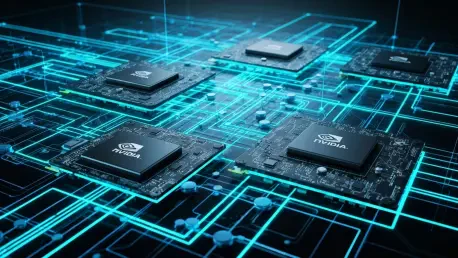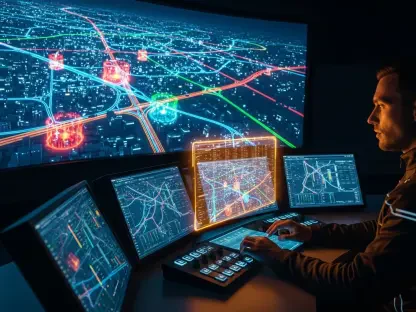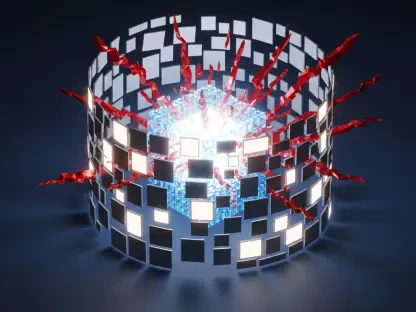In the fast-paced realm of artificial intelligence (AI), where breakthroughs seem to emerge daily, Nvidia Corporation stands out not only for its renowned graphical processing units (GPUs) but also for an often-overlooked yet indispensable element: network interconnects. These interconnects act as the hidden framework that binds thousands of accelerators into a cohesive, high-performing system, effectively turning sprawling data centers into unified supercomputers. While the spotlight frequently shines on GPUs as the engines of AI, the silent efficiency of networking infrastructure is proving to be just as vital in meeting the escalating demands of modern AI workloads. This exploration uncovers Nvidia’s strategic pivot toward networking as a fundamental pillar of AI infrastructure, offering a glimpse into how this technology is reshaping the very concept of computational power and scalability in data centers across the globe.
The insights shared by Gilad Shainer, Nvidia’s Senior Vice President of Marketing, during a detailed discussion with John Furrier of theCUBE, underscore a pivotal shift in the industry. Shainer articulates that the future of AI is deeply rooted in distributed computing, moving far beyond the capabilities of standalone hardware. Today’s AI models require the seamless collaboration of thousands, if not hundreds of thousands, of GPUs, a feat that hinges on robust networking solutions to ensure efficiency and speed. This transformation redefines traditional compute units, shifting the focus from isolated servers to entire data centers operating as singular, high-performance entities designed to tackle the complexities of AI processing.
The Evolution of AI Infrastructure
Transforming Data Center Dynamics
The landscape of AI infrastructure is undergoing a profound transformation, driven by the need for systems that can handle unprecedented computational demands. Nvidia is at the forefront of this change, emphasizing that modern AI models no longer function effectively on a single GPU or server but rely on vast networks of accelerators working in unison. Network interconnects are the critical glue in this setup, enabling data centers to operate as synchronized supercomputers. This shift challenges the conventional understanding of compute resources, pushing the industry to rethink infrastructure design. Shainer points out that without advanced networking, the massive scale required by AI applications would remain unattainable, highlighting the urgency of adapting to a distributed computing model where every component must align perfectly to deliver results.
This evolution also brings to light the scalability challenges that come with integrating thousands of GPUs into a cohesive system. Network interconnects must manage enormous data flows with precision, ensuring that no single accelerator becomes a bottleneck in the process. Nvidia’s focus on creating robust networking solutions addresses these hurdles, allowing for seamless expansion as AI workloads grow in complexity. The ability to transform a data center into a unified engine is not just a technical achievement but a strategic necessity, as businesses and research institutions increasingly rely on AI to drive innovation. By prioritizing interconnects, Nvidia is paving the way for infrastructure that can keep pace with the rapid advancements in AI technology, ensuring that performance remains consistent even at the largest scales.
Addressing Synchronization Challenges
Synchronization stands as a cornerstone of distributed AI systems, where the simultaneous operation of countless GPUs is non-negotiable for efficient processing. Nvidia’s network interconnects are engineered to deliver data to each accelerator at the same moment, minimizing delays and avoiding jitter—uneven data delivery that can disrupt workflows. This low-latency communication is essential for maintaining harmony across sprawling systems, effectively turning disparate GPU application-specific integrated circuits (ASICs) into a single, powerful supercomputer. The precision of these interconnects ensures that AI workloads, which often involve intricate calculations and vast datasets, are executed without hiccups, meeting the stringent demands of modern applications.
Beyond just maintaining timing, the role of interconnects in synchronization extends to enhancing overall system reliability. Any lapse in data delivery can cascade into significant delays, undermining the performance of AI models that rely on real-time processing. Nvidia’s advancements in networking technology tackle this issue head-on, providing a stable framework where GPUs can operate as a unified entity. This capability is particularly crucial for industries such as autonomous vehicles and large-scale simulations, where split-second decisions depend on flawless data handling. By eliminating latency barriers, Nvidia ensures that its infrastructure supports the next generation of AI innovations, where speed and accuracy are paramount to success.
Innovations Driving AI Performance
Holistic Integration Through Co-Design
Nvidia’s approach to AI infrastructure transcends traditional hardware focus, embracing a comprehensive strategy known as co-design that integrates hardware with software, libraries, and management tools into a unified stack. This methodology ensures that AI developers achieve critical performance metrics such as high tokens-per-second rates and predictable runtime efficiency. Shainer emphasizes that the success of an AI supercomputer is not measured solely by its technical specifications but by tangible outcomes like productivity and processing speed. By weaving together these various elements, Nvidia creates an ecosystem where each component enhances the others, delivering results that meet the rigorous needs of modern AI development.
This integrated approach also addresses the diverse requirements of AI applications, which vary widely in scope and complexity. Co-design allows Nvidia to tailor solutions that optimize performance across different use cases, from machine learning models to natural language processing systems. Developers benefit from a streamlined environment where software and hardware work in tandem, reducing the friction often encountered in disjointed systems. The result is a more efficient workflow, where the focus shifts from troubleshooting technical mismatches to driving innovation. Nvidia’s commitment to this strategy positions it as a leader in creating AI infrastructure that not only meets current demands but also anticipates future challenges in the ever-evolving tech landscape.
Optimizing Density and Energy Use
One of the pressing challenges in scaling AI infrastructure lies in managing density and energy consumption within data centers. Nvidia addresses this by packing more GPU ASICs into smaller physical spaces, reducing the dependency on power-intensive optical links in scale-up scenarios and favoring efficient copper-based connections instead. For larger scale-out setups, innovations like Quantum-X InfiniBand and Spectrum-X Ethernet Photonics with co-packaged optics minimize energy use for data movement between racks. These advancements reflect a deliberate effort to balance high performance with sustainability, ensuring that AI systems can grow without imposing unsustainable energy costs on operators.
Energy efficiency is not just a technical concern but a strategic imperative as AI workloads continue to expand across industries. High-density configurations allow data centers to maximize computational power while keeping physical and energy footprints in check, a critical consideration in an era of heightened environmental awareness. Nvidia’s focus on technologies that reduce power consumption for data transfers demonstrates a forward-thinking approach to infrastructure design. This balance ensures that as AI applications become more complex, the underlying systems remain viable and cost-effective, supporting long-term growth without compromising on performance or ecological responsibility.
Shaping the Future of AI Factories
Networking as a Foundational Element
A notable trend in the AI industry is the growing recognition of networking as the foundational “operating system” of infrastructure, a perspective that Nvidia actively champions. While GPUs often dominate discussions about AI computing power, network interconnects are increasingly seen as indispensable for achieving scalability and performance at the levels required today. Shainer’s insights reveal how these interconnects enable the transformation of data centers into AI factories—massive, synchronized engines built for unprecedented computational demands. Nvidia’s leadership in this domain is evident as it drives the conversation toward distributed systems, where connectivity is as critical as raw processing power.
This shift in focus also underscores the importance of adaptability in AI infrastructure. As models grow larger and more intricate, the ability to seamlessly connect and coordinate thousands of accelerators becomes a defining factor in system success. Nvidia’s networking solutions are designed with this scalability in mind, ensuring that data centers can evolve into AI factories capable of handling future demands. By positioning interconnects as a core component, Nvidia is not just responding to current needs but actively shaping the trajectory of AI development, setting a standard for how infrastructure should support the next wave of technological advancements.
Prioritizing Sustainable Practices
Sustainability has emerged as a central theme in the design of AI infrastructure, with Nvidia leading the charge through innovations that prioritize energy efficiency alongside performance. High-density configurations and advanced optics like those in Quantum-X InfiniBand platforms demonstrate a commitment to reducing power consumption while maintaining the computational intensity required for AI workloads. This dual focus aligns with an industry-wide push toward greener data centers, addressing the immense pressure that AI growth places on energy resources. Nvidia’s efforts ensure that infrastructure can scale responsibly, meeting both technological and environmental goals.
The emphasis on sustainable practices also reflects a broader understanding of AI’s long-term impact on global systems. As applications permeate sectors from healthcare to logistics, the energy demands of supporting infrastructure must be managed with care to avoid undue strain. Nvidia’s strategic innovations offer a blueprint for how performance and efficiency can coexist, providing a model for other industry players to follow. By integrating sustainability into the core of its AI factory vision, Nvidia not only enhances its technological offerings but also contributes to a more balanced approach to progress, ensuring that growth in AI does not come at an unsustainable cost.
Reflecting on Nvidia’s Impact
Building on Past Achievements
Looking back, Nvidia’s journey in redefining AI infrastructure through network interconnects marked a significant turning point in how data centers were perceived and utilized. The emphasis on transforming these facilities into synchronized AI factories showcased a vision that went beyond mere hardware advancements. By addressing synchronization, co-design, and energy efficiency, Nvidia tackled the core challenges of distributed computing with precision. The company’s ability to integrate networking as a vital component of AI systems set a benchmark that reshaped industry expectations, proving that connectivity was just as essential as processing power in driving innovation.
Charting the Path Forward
As the industry reflected on these strides, the next steps became clear: continued investment in networking technologies would be crucial for sustaining AI’s rapid evolution. Stakeholders needed to prioritize scalable, energy-efficient solutions that could support increasingly complex workloads. Exploring further innovations in co-packaged optics and high-density designs offered a promising avenue for balancing performance with sustainability. Nvidia’s legacy provided a foundation, but ongoing collaboration across the tech ecosystem was essential to ensure that AI factories remained adaptable, efficient, and ready for the challenges ahead.









